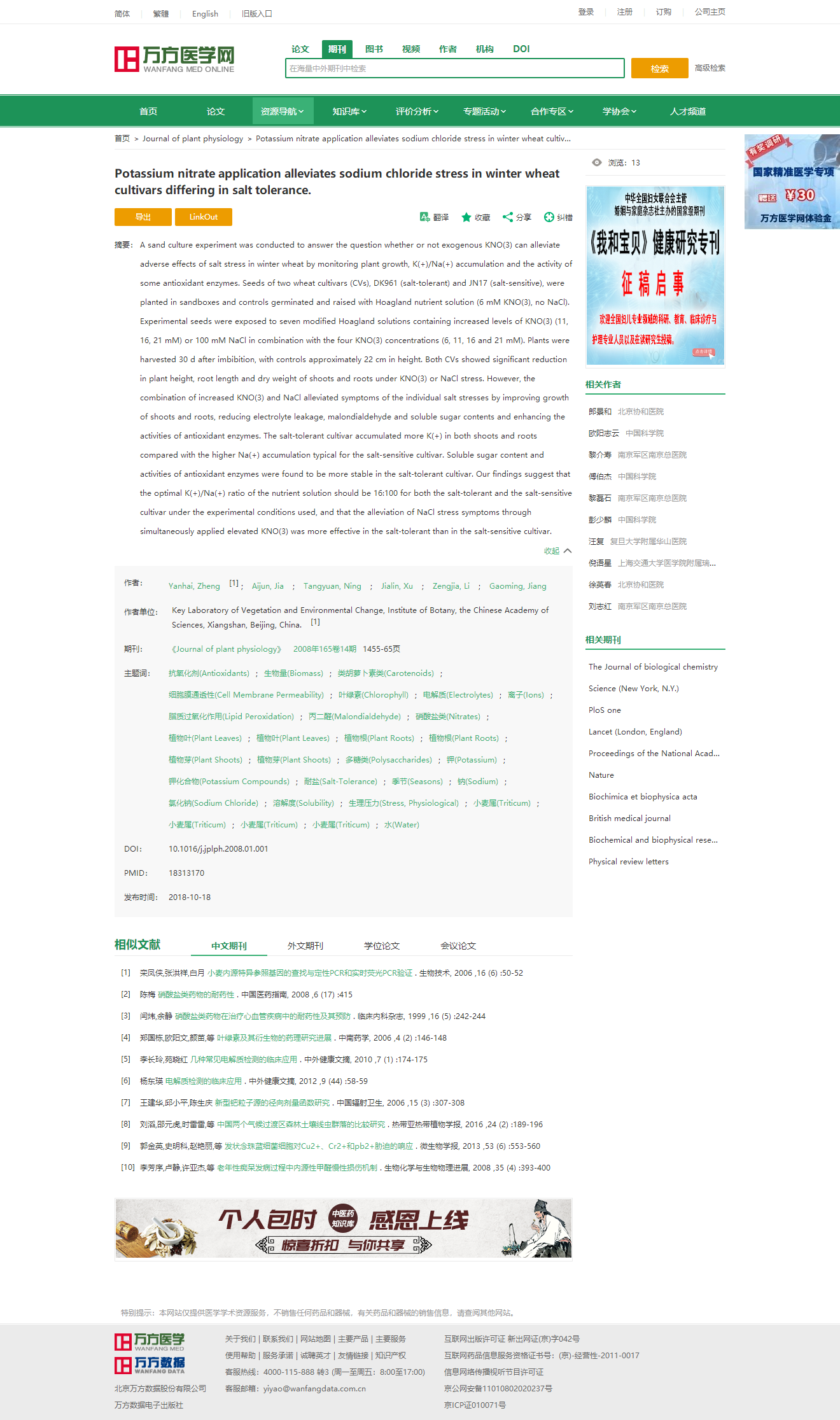博文
施用硝酸钾可缓解不同耐盐性冬小麦品种的氯化钠胁迫
|||
施用硝酸钾可缓解不同耐盐性冬小麦品种的氯化钠胁迫
郑延海、贾爱静、宁唐原、徐杰、李增嘉、蒋高明
中国科学院植物研究所植被与环境变化重点实验室
山东农业大学作物生物学国家重点实验室
Journal of Plant Physiology, 2008, 165: 1455-1465
摘要 通过监测植物生长、K+/Na+积累和部分抗氧化酶活性,来回答外源KNO3能否缓解冬小麦盐胁迫的负面效应。将两个小麦品种DK961(耐盐)和JN17(盐敏感)的种子置于沙培箱中,用Hoagland营养液(6mm KNO3,不含NaCl)进行发芽培养。将实验种子暴露于含有增加的KNO3(11、16、21 mM)或100 mM NaCl的七种改良Hoagland溶液中,并进行四种KNO3浓度(6、11、16和21 mM)处理。植物吸胀后30 d收获,对照高度约22厘米。在KNO3和NaCl胁迫下,两种品种小麦的株高、根长和茎根干重均显著降低。然而,KNO3通过提高芽和根的生长、减少电解质渗漏、丙二醛和可溶性糖含量和增强抗氧化酶的活性,从而减轻个体盐胁迫的症状。耐盐品种在地上部和根部积累的钾离子比盐敏感品种积累的钾离子多。可溶性糖含量和抗氧化酶活性在耐盐品种中较为稳定。结果表明,耐盐品种和盐敏感品种营养液的最佳钾钠比均为16:100,施用高浓度硝酸钾缓解NaCl胁迫,在耐盐品种中比在盐敏感品种中更为有效。
Potassium nitrate application alleviates sodium chloride stress in winter wheat cultivars differing in salt tolerance
Zheng YH, Jia AJ, Ning TY, Xu JL, Li ZJ, Jiang GM
Key Laboratory of Vegetation and Environmental Change, Institute of Botany, the Chinese Academy of Sciences, Xiangshan, Beijing, China
State Key Laboratory of Crop Biology, Shandong Agricultural University
Journal of Plant Physiology, 2008, 165: 1455-1465.
Abstract: A sand culture experiment was conducted to answer the question whether or not exogenous KNO3 can alleviate adverse effects of salt stress in winter wheat by monitoring plant growth, K(+)/Na(+) accumulation and the activity of some antioxidant enzymes. Seeds of two wheat cultivars (CVs), DK961 (salt-tolerant) and JN17 (salt-sensitive), were planted in sandboxes and controls germinated and raised with Hoagland nutrient solution (6 mM KNO3, no NaCl). Experimental seeds were exposed to seven modified Hoagland solutions containing increased levels of KNO3 (11, 16, 21 mM) or 100 mM NaCl in combination with the four KNO3 concentrations (6, 11, 16 and 21 mM). Plants were harvested 30 d after imbibition, with controls approximately 22 cm in height. Both CVs showed significant reduction in plant height, root length and dry weight of shoots and roots under KNO3 or NaCl stress. However, the combination of increased KNO3 and NaCl alleviated symptoms of the individual salt stresses by improving growth of shoots and roots, reducing electrolyte leakage, malondialdehyde and soluble sugar contents and enhancing the activities of antioxidant enzymes. The salt-tolerant cultivar accumulated more K(+) in both shoots and roots compared with the higher Na(+) accumulation typical for the salt-sensitive cultivar. Soluble sugar content and activities of antioxidant enzymes were found to be more stable in the salt-tolerant cultivar. Our findings suggest that the optimal K(+)/Na(+) ratio of the nutrient solution should be 16:100 for both the salt-tolerant and the salt-sensitive cultivar under the experimental conditions used, and that the alleviation of NaCl stress symptoms through simultaneously applied elevated KNO3 was more effective in the salt-tolerant than in the salt-sensitive cultivar.

https://blog.sciencenet.cn/blog-475-1212498.html
上一篇:农业离不开化学合成物质的背后原因在哪里?
下一篇:美国粮食有多便宜?